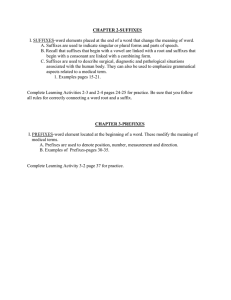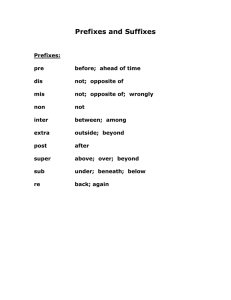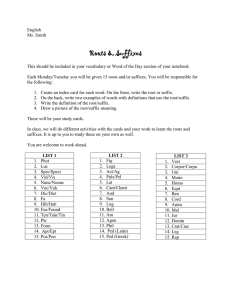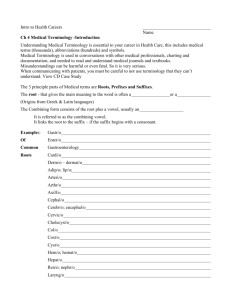CHAPTER 2 – SUFFIXES OBJECTIVES On completion of this
advertisement
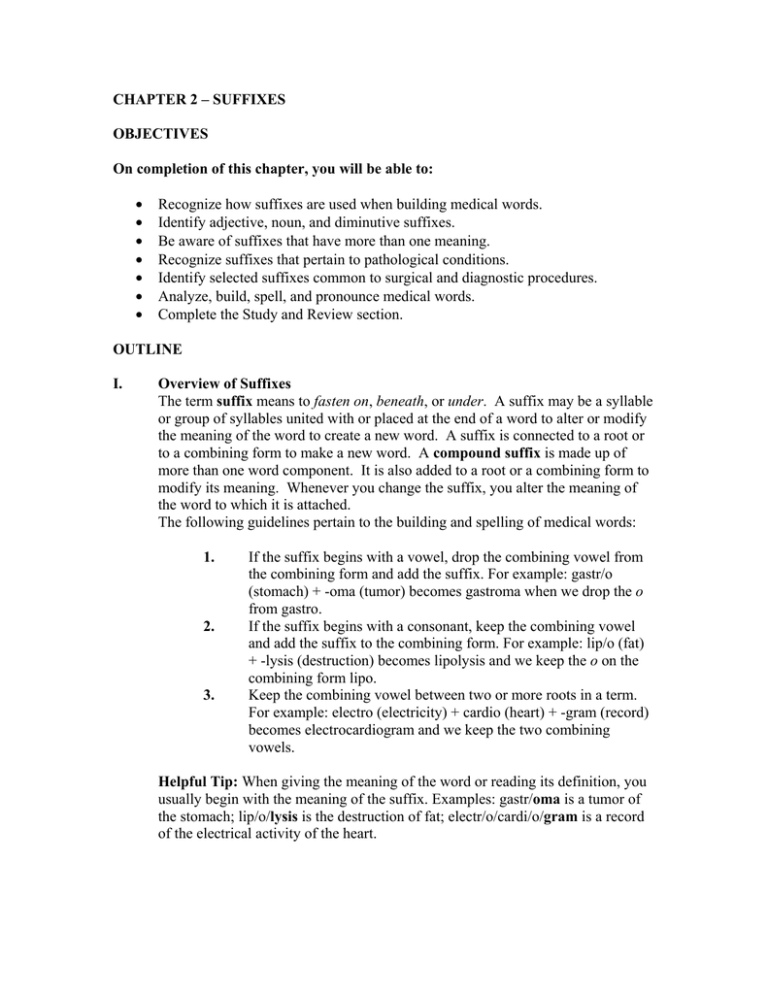
CHAPTER 2 – SUFFIXES OBJECTIVES On completion of this chapter, you will be able to: • • • • • • • Recognize how suffixes are used when building medical words. Identify adjective, noun, and diminutive suffixes. Be aware of suffixes that have more than one meaning. Recognize suffixes that pertain to pathological conditions. Identify selected suffixes common to surgical and diagnostic procedures. Analyze, build, spell, and pronounce medical words. Complete the Study and Review section. OUTLINE I. Overview of Suffixes The term suffix means to fasten on, beneath, or under. A suffix may be a syllable or group of syllables united with or placed at the end of a word to alter or modify the meaning of the word to create a new word. A suffix is connected to a root or to a combining form to make a new word. A compound suffix is made up of more than one word component. It is also added to a root or a combining form to modify its meaning. Whenever you change the suffix, you alter the meaning of the word to which it is attached. The following guidelines pertain to the building and spelling of medical words: 1. 2. 3. If the suffix begins with a vowel, drop the combining vowel from the combining form and add the suffix. For example: gastr/o (stomach) + -oma (tumor) becomes gastroma when we drop the o from gastro. If the suffix begins with a consonant, keep the combining vowel and add the suffix to the combining form. For example: lip/o (fat) + -lysis (destruction) becomes lipolysis and we keep the o on the combining form lipo. Keep the combining vowel between two or more roots in a term. For example: electro (electricity) + cardio (heart) + -gram (record) becomes electrocardiogram and we keep the two combining vowels. Helpful Tip: When giving the meaning of the word or reading its definition, you usually begin with the meaning of the suffix. Examples: gastr/oma is a tumor of the stomach; lip/o/lysis is the destruction of fat; electr/o/cardi/o/gram is a record of the electrical activity of the heart. A. General Use Suffixes – suffixes, when written, are all preceded by a hyphen (-) to signify that they are to be linked to the end of a root or combining form. 1. Selected Suffixes for General Use Meaning Suffix -algesia condition of pain -ant forming -ase enzyme -ate use, action -blast immature cell, germ cell -cide to kill -crit to separate -cuspid point -cyst bladder, sac -cyte cell -dipsia thirst -drome a course -er relating to, one who -gen formation, produce -genesis formation, produce -ide having a particular quality -ive nature of, quality of -liter liter -logy study of -lymph clear fluid, serum, pale fluid -or one who, a doer -phil attraction -stasis control, stop, stand still -therapy treatment -thermy heat -um tissue, structure -uria urination, condition of urine B. Grammatical Suffixes – those suffixes that may be attached to a word root to form a part of speech, especially a noun or adjective, or to make a medical word singular or plural in its form. They are also used to indicate a diminutive form of a word that specifies a smaller version of the object indicated by the word root. They are as follows: 1. Adjective Suffixes That Mean Pertaining To Suffix Definition -ac pertaining to -ad pertaining to -al pertaining to -ar pertaining to -ary pertaining to -ic -ile -ior -ose -ous -tic -us -y pertaining to pertaining to pertaining to pertaining to pertaining to pertaining to pertaining to pertaining to 2. Noun Suffixes That Mean Condition, Treatment, or Specialist Suffix Definition -esis condition -ia condition -ism condition -iatry treatment -ician a physician who specializes in -ist a physician who specializes in -osis condition -y condition 3. Diminutive Suffixes That Mean Small or Minute Definition Suffix -cle small -icle little -ole small -ula small -ule small C. Suffixes That Have More Than One Meaning -– these suffixes have more than one meaning, thereby making it a little more difficult when defining medical terms to which they are attached. 1. Selected Suffixes That Have More Than One Meaning Suffix Meaning -ate use, action, having the form of, possessing -blast immature cell, germ cell, embryonic cell -ectasis dilatation, dilation, distention, stretching, expansion -gen formation, produce -genesis formation, produce -genic formation, produce -gram a weight, mark, record -ive nature of, quality of -lymph serum, clear fluid, pale fluid -lysis destruction, separation, breakdown, loosening, dissolution -penia -plasm -plegia -ptosis -rrhea -scopy -spasm -staxis -trophy -y D. lack of, deficiency, abnormal reduction a thing formed, plasma stroke, paralysis, palsy prolapse, drooping, falling down, sagging flow, discharge to view, examine, visual examination tension, spasm, contraction dripping, trickling nourishment, development process, condition, pertaining to Suffixes That Pertain to Pathological Conditions – suffixes that carry meanings such as pain, swelling, weakness, softening, inflammation, and tumor are often combined with roots or combining forms to describe pathological conditions. 1. Selected Suffixes That Pertain to Pathological Conditions Meaning Suffix -algia pain, ache -asthenia weakness -betes to go -cele hernia, tumor, swelling -cusis hearing -derma skin -dynia pain, ache -ectasis dilation, distention -edema swelling -emesis vomiting -ion process -itis inflammation -kinesis motion -lepsy seizure -lexia diction, word, phrase -malacia softening -mania madness -megaly enlargement, large -mnesia memory -noia mind -oid resemble -oma tumor -opia sight, vision -oxia oxygen -pathy disease, emotion -penia deficiency -pepsia -phagia -phasia -phobia -plasia -plasm -plegia -pnea -ptosis -ptysis -rrhage -rrhea -rrhexis -spasm -trophy E. to digest to eat, to swallow to speak, speech fear formation, produce a thing formed, plasma paralysis, stroke breathing drooping, prolapse, sagging spitting bursting forth flow, discharge rupture tension, spasm, contraction nourishment, development Suffixes Associated with Surgical and Diagnostic Procedures – suffixes with meanings such as puncture, surgical excision, instrument to measure, and new opening are often combined with roots or combining forms to describe surgical and/or diagnostic procedures. 1. Selected Suffixes Used in Surgical and Diagnostic Procedures Meaning Suffix -centesis surgical puncture -clasis a breaking -desis binding -ectomy surgical excision, surgical removal, resection -gram a weight, mark, record -graph instrument for recording -graphy recording -ize to make, to treat or combine with -lysis destruction, separation, breakdown, loosening -meter instrument to measure, measure -metry measurement -opsy to view -pexy surgical fixation -pheresis remove -plasty surgical repair -rrhaphy suture -scope instrument for examining -scopy visual examination, to view, examine -stomy new opening -tome instrument to cut -tomy incision -tripsy crushing II. Building Your Medical Vocabulary A. Medical Words and Definitions – this section provides the foundation for learning medical terminology. Medical words can be made up of four types of word parts: 1. Prefix (P) 2. Root (R) 3. Combining Forms (CF) 4. Suffixes (S) By connecting various word parts in an organized sequence, thousands of words can be built and learned. In the text, the word list is alphabetized so one can see the variety of meanings created when common prefixes and suffixes are repeatedly applied to certain word roots and/or combining forms. Words shown in pink are additional words related to the content of this chapter that have not been divided into word parts. III. Study and Review (pp. 28-29)
